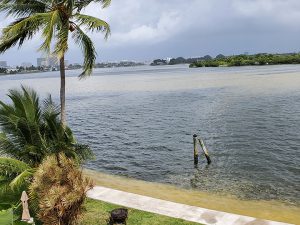Nearly two weeks after thousands of fish washed up throughout areas of Miami-Dade County, the low dissolved oxygen-driven fish kill event seems to be over. Dissolved oxygen (DO) levels throughout the Bay have stabilized, and the large quantities of dead fish have subsided.
The first sightings of dead fish were reported at Morningside Park on Monday, August 10, and spread to locations north and south along Biscayne Bay. On Wednesday, August 12, the Pelican Harbor Seabird Station (PHSS) reported hundreds of stranded stingrays as well as fish struggling near the water’s surface. DO levels at the bottom of the Bay were consistently lower than at the surface, suggesting that this event was not solely driven by increased temperature (warmer water has less available DO, and typically, the deeper water is cooler and has more DO) but likely driven by multiple factors which are extraordinarily challenging to pinpoint. Aging sewer infrastructure, non-point pollution sources, freshwater flows, and coastal development are all contributors of nutrients that increase primary productivity, leading to low DO, culminating in this fish kill event.
In the case of the fish kill, higher levels of DO at the surface of water can be attributed to diffusion with the atmosphere. Enter seagrass. For submerged aquatic vegetation, fish and invertebrates, oxygen throughout the water is needed. Seagrass produces oxygen by way of photosynthesis, which is critical for water at the bottom. For this reason, the seagrass die-off in the northern Bay’s Julia Tuttle basin must be factored in as well.
On Friday, August 14, the water that came into the PHSS basin at high tide had turned a turbid, dark green. This was likely a sign of what can be thought of as a “second phase” of the fish kill: an algae bloom indicated by high concentrations of chlorophyll, in response to the nutrients as the dead fish begin to decompose. The green water was observed near Pelican Harbor and in other parts of the Bay for the next few days.
By August 21, researchers from FIU’s Institute of the Environment confirmed an algae bloom of the genus Chaetoceros, a diatom, in north Biscayne Bay. This is not a harmful algal bloom, in other words, this genus of algae is not toxic nor does it produce toxins, but a sign that conditions in the Bay are not quite “normal” yet. Signs of the bloom presented after the fish kill event ended, so it is likely that the fish kill may have contributed to the bloom and not the other way around. This algae bloom is being continuously monitored by FIU and others.

To put things in perspective, at PHSS on August 12 (the first day the staff observed stranded fish and rays), DO was 0.48 mg/L at the bottom, and 1.96 mg/L at the surface. Sustained dissolved oxygen levels less than 2 mg/L are considered dangerous for aquatic life, and fish exposed to levels this low for one to four days can result in large-scale mortality events (Wilson 2009). Dissolved oxygen levels at PHSS are within acceptable ranges again. As of this Monday, August 24, DO at the bottom was 5.27 mg/L, and 5.36 mg/L at the surface. The algae bloom has subsided in this localized area. PHSS continues to run the aerators and sump pump to help mix and re-oxygenate the water, and will continue to do so until they receive guidance that directs otherwise.
The high winds we experienced over Sunday the 23rd, Sunday the 24th, and Monday the 25th from Hurricane Laura likely helped in circulating the water throughout the Bay and dispersing the nutrients and algae, and providing much needed oxygen to the warm waters. Now that the winds are returning to a more regular summer pattern, continued monitoring remains important. I will continue sampling at PHSS and at Matheson Hammock, where I have been taking readings to establish a baseline just in case we have another low dissolved oxygen episode or fish kill, and/or the occurrence makes it way towards the central and south Bay.

Coordination calls continue on a daily basis to share information, and researchers have outlined plans for further targeted monitoring. If you observe anything unusual in the Bay, please report it to: hello@miamiwaterkeeper.org.
References:
Wilson, C. 2009. Water Quality Notes: Dissolved Oxygen. https://edis.ifas.ufl.edu/ss525
 0
0
